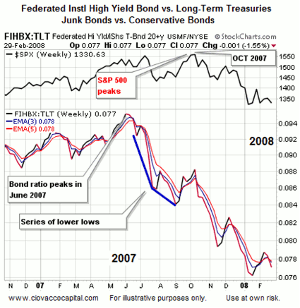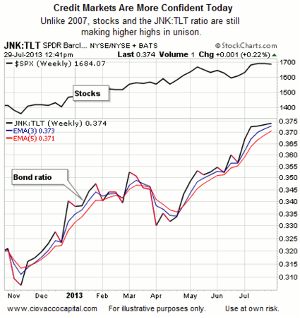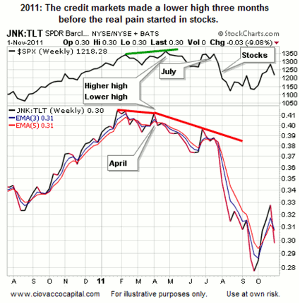One of the many tenets on Wall Street is that debt investors are often a step or two ahead of stock investors when it comes to identifying slowing economic growth, writes Chris Ciovacco on SafeHaven.com.
Investors Migrating to Riskier Debt
From a common sense perspective, it makes some sense. Debt investors tend to be more risk averse, and thus may dot a few more due diligence i's and cross a few more analytical t's.
From Bloomberg: “Investors are pumping money into junk bonds globally at the fastest pace ever while tempering their enthusiasm for higher-rated debt, demonstrating a preference for yield over stability. Investors who abandoned junk bonds at a record pace in June are now casting aside concern that the securities will lose their allure as the Federal Reserve slows its record stimulus because of the extra yield the securities offer.”
Sentences about capital flows that contain extreme expressions, such as "at the fastest pace ever," tend to raise red flags about sentiment. Sentiment, at extremes, can be a valuable contrary indicator.
Similarities To 2007-2008?
One way to evaluate any situation in the markets is to compare the present day to previous bearish market turns and look for similarities. The Junk Bond Spyder ETF (JNK) can be used as an excellent proxy for the high-yield debt markets. Since JNK did not start trading until 2008, to go back to the stock market's October 2007 peak, the graph below uses a mutual fund (FIHBX) as a proxy for JNK. The top of the chart shows the S&P 500 for comparison purposes. The ratio of junk debt to conservative debt is below the S&P 500. When the bond ratio rises, demand for junk bonds is greater than demand for conservative Treasuries. Were the debt markets a step ahead of stocks in 2007? Yes, as you can see below, bond investors started to migrate away from junk bonds toward more conservative Treasuries (TLT) well before stocks peaked (falling ratio). The credit markets correctly forecasted the coming risks in June 2007, or four months before a major bear market began in October.
2013: Credit Markets Look Better
How does the ratio of junk bonds vs. Treasuries look today? Answer: much better than it did in October 2007 when the stock market peaked.
Bonds Not Forecasting a Recession
The chart above tells us that the credit markets see a much lower probability of recession today than they did in mid-to-late 2007. When a recession hits, the odds of riskier bonds going into default increase. Under those conditions, investors migrate away from junk debt, rather than toward it as they are doing today. The JNK:TLT ratio is one of many risk-on vs. risk-off ratios used by our market model to monitor the health of the economy and financial markets.
Are Credit Markets Preparing for a Better Economy?
Higher interest rates are to be expected as the economy stabilizes and growth picks up. Bloomberg noted another possible hint coming from the recent outperformance of riskier debt relative to more conservative offerings:
"High yield is far less vulnerable to a rise in interest rates than investment grade," Gregory Kamford, a credit strategist at RBS Securities Inc. in Stamford, Connecticut, said in a telephone interview. The securities will "materially outperform investment grade over the balance of 2013," he said.
Bonds Helped in 2011
Are the credit markets always helpful in forecasting impending stock market weakness? No, but the track record is strong enough to be very helpful over longer periods of time. Similar to 2007, the JNK:TLT ratio peaked in 2011 well before the European debt crisis assisted with a sharp decline in equities in July/August.
Investment Implications
The Fed's desire to taper their bond purchases is concerning and something that we will monitor closely. However, the known desire to taper has not yet shown up in the credit markets in the form of risk aversion as it did in 2007 and 2011 prior to sharp declines in stocks. As long as that is the case, we will continue to favor stocks (SPY) over bonds (AGG). We will also hold our positions in leading sectors such as financials (XLF), technology (QQQ), and small caps (IWM). If the messages from the markets change, we are happy to migrate toward a more conservative stance.
By Chris Ciovacco, Contributor, SafeHaven.com
























